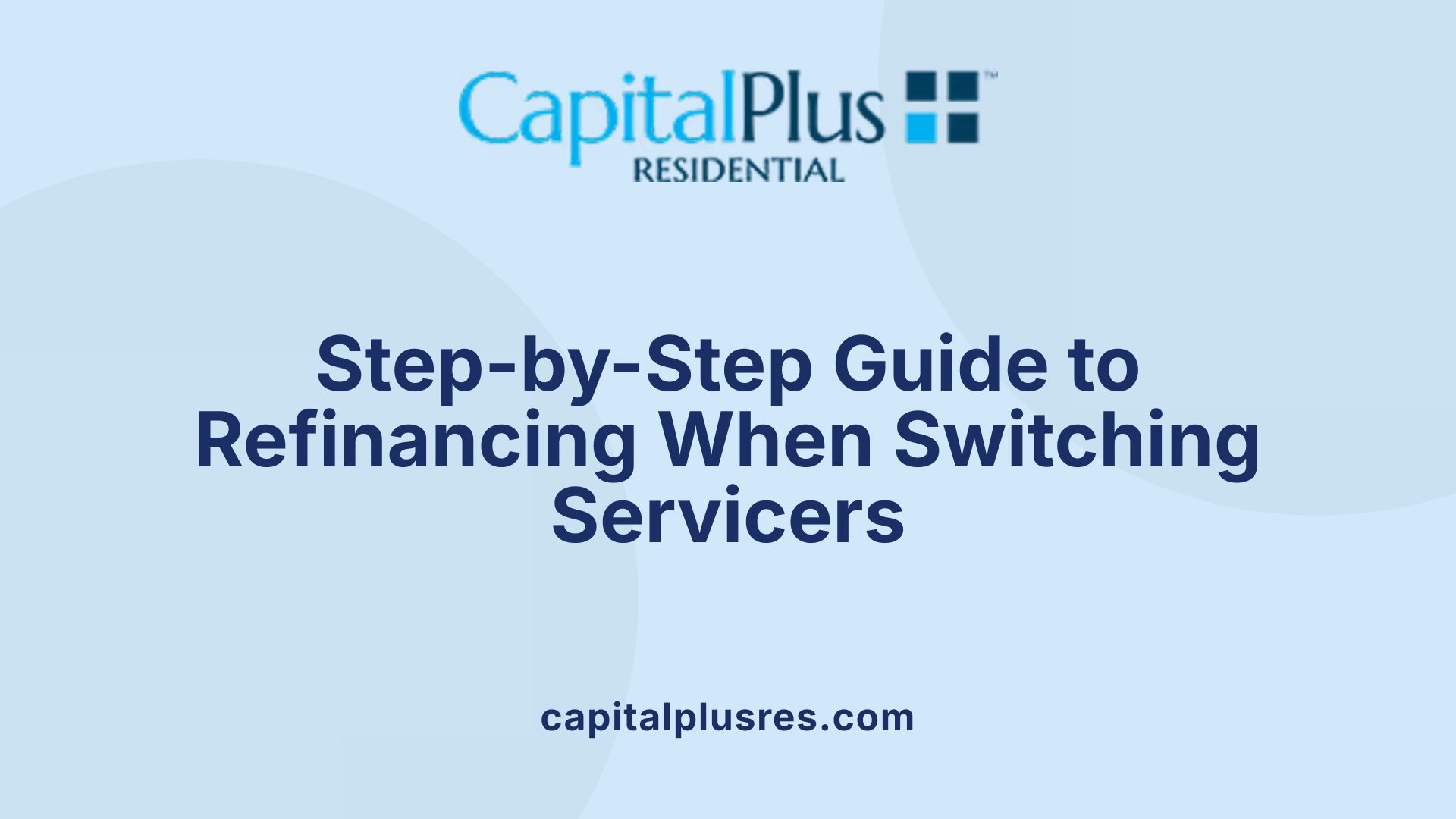Understanding Refinancing and Mortgage Servicing Dynamics
Refinancing a mortgage often serves to reduce interest rates or access home equity, but another key aspect that homeowners might consider is changing their mortgage servicer through refinancing. While the loan's ownership and servicing rights can shift without refinancing, choosing to refinance provides direct control over servicer selection and loan terms. This article explores the nuances of refinancing as a strategy to switch mortgage servicers, the benefits and risks involved, and important considerations for homeowners aiming to optimize their mortgage experience.
What Refinancing Means in the Context of Mortgage Servicers

What is Refinancing and How Does It Relate to Changing Mortgage Servicers?
Refinancing a mortgage means obtaining a new loan to replace your current one. This is usually done to secure better interest rates, adjust loan terms, access home equity, or lower monthly payments. When you refinance, you pay off the original mortgage with the new loan, which effectively closes your previous loan account.
Difference Between Loan Originator and Servicer
It's important to understand the roles involved in your mortgage. The loan originator is the lender who processes, underwrites, and closes the loan. However, this lender may not be the same as the mortgage servicer, who handles the daily management of your loan—collecting payments, maintaining records, and providing customer service.
How Refinancing Can Influence Servicer Change
Refinancing directly impacts who services your mortgage. Because refinancing closes your existing loan and opens a new one, it offers an opportunity to switch mortgage servicers. For example, you can refinance with a lender that services their own loans or works with different servicers. This change means the day-to-day management of your loan could be handled by a new company. However, once your mortgage is closed, switching servicing companies without refinancing is generally not possible unless your loan is sold or transferred.
This process allows homeowners flexibility in choosing a service experience that fits their needs, but it also requires understanding the potential costs and steps involved in applying for a new loan and completing closing paperwork.
Understanding the Roles: Lenders, Loan Originators, and Mortgage Servicers

What are the differences between mortgage lenders, originators, and servicers?
Mortgage lenders and loan originators are responsible for processing, underwriting, and closing on a loan. They handle the initial steps of mortgage lending, such as evaluating borrower qualifications and approving the loan. Once the loan is closed, however, the daily management of the mortgage often passes to a mortgage servicer.
Mortgage servicers manage day-to-day tasks like processing payments, managing escrow accounts, and providing customer service. Unlike lenders, servicers do not own the loan but act as the point of contact for borrowers during the loan term.
Why servicers can change without borrower refinancing
The servicing rights to a mortgage can be sold or transferred to another company without affecting the loan terms. This is a common industry practice allowing lenders to free up capital and manage risks. When servicing rights are sold, the borrower will receive notifications about the new servicer, including updated contact information and transfer dates.
Importantly, the change in servicer does not require borrowers to refinance or take any action beyond updating payment information if needed.
Loan ownership vs servicing rights
Mortgage loans may be owned by entities such as Fannie Mae, Freddie Mac, Ginnie Mae, or private investors. Ownership determines who holds the loan on the books and ultimately benefits from it, while servicing rights determine who manages the loan's administration.
Ownership and servicing are often separate; for instance, a lender may originate a loan, sell ownership to an investor, but retain servicing rights—or vice versa. This separation explains why the company managing your payments may differ from the original lender.
Understanding these distinctions helps homeowners navigate changes to their loan servicing without confusion or unnecessary refinancing.
How Mortgage Servicing Rights Transfer Affects Borrowers Without Refinancing

Servicer transfers without refinancing
Mortgage servicing rights can change hands even if the borrower does not refinance their loan. When a mortgage is sold or the servicing rights are transferred to another company, the new servicer takes over responsibilities like handling payments and customer service. However, this transfer does not alter the borrower's loan terms or interest rate.
Notification and borrower rights during transfer
Lenders and servicers are required to notify borrowers in advance of any servicing rights transfer. This notification includes details such as the new servicer’s contact information and the date when they begin managing the loan. During this process, borrowers have rights including maintaining records, updating automated payments, and ensuring continuous service without disruption.
Impact on loan terms
While servicing may shift to a different company, the terms of the mortgage loan—including interest rate, loan balance, and repayment schedule—remain unchanged. The transfer primarily affects who manages day-to-day loan administration rather than the underlying contractual obligations.
This system allows lenders to free capital and reduce risks by selling servicing rights, supporting the mortgage industry without negatively impacting borrowers who remain on their original loan terms. For example, large companies like Pennymac both originate and service loans, maintaining ongoing relationships with homeowners even as servicing rights transfer in the industry.
Why Homeowners Consider Refinancing to Change Their Mortgage Servicer

Why would a borrower refinance specifically to change their mortgage servicer?
Borrowers sometimes decide to refinance their mortgage to switch servicers deliberately. While mortgage servicing rights can be transferred from one company to another without affecting the loan terms, these transfers are typically outside the borrower's control. Refinancing allows borrowers to proactively select a lender or servicer that better fits their needs.
Motivations for switching servicers
Many homeowners seek improved customer service or more efficient loan management. Refinancing with a preferred servicer can offer easier access to account information, more responsive support, and options for consolidated accounts. Some lenders, like Pennymac, both originate and service loans, fostering a consistent and streamlined relationship throughout the life of the mortgage.
Benefits of selecting a preferred servicer
Refinancing to choose a servicer with a strong reputation can lead to advantages such as negotiated loan terms, potentially lower fees, and more tailored services. Additionally, refinancing with the same lender may reduce application complexities and leverage existing documentation. The familiarity can make the refinancing process smoother and more convenient.
Limitations of servicer transfers without refinancing
It's important to note that when servicing rights are sold or transferred between companies, the loan’s original terms do not change. Borrowers do not get to choose the new servicer in these transactions and must adapt to the new management company. To have control over the servicer, borrowers generally need to refinance, which involves applying for a new loan and going through the underwriting process again.
Refinancing to change mortgage servicers is a strategic move that can improve a homeowner’s mortgage management experience, but it involves weighing the costs and benefits involved in the refinancing process itself.
The Refinancing Process: Steps Involved When Changing Servicers

What is the refinancing process like when changing mortgage servicers?
Refinancing to change mortgage servicers involves obtaining a new mortgage to pay off the existing one. This process is similar to purchasing a home and requires several key steps.
Application and documentation
The first step is applying for the new loan with a different lender. Applicants must submit detailed financial information and documentation, such as income verification, credit history, and property details. Online pre-approval options offer fast responses without impacting credit scores.
Appraisal and underwriting
Once the application is submitted and a potential interest rate is secured, the new lender orders a home appraisal to assess current property value. This appraisal can come with fees and is a crucial part of underwriting. Underwriting then involves verifying all financial data and assessing the borrower’s ability to repay the loan.
Closing requirements specific to servicer change
Closing on the new mortgage finalizes the refinance. Borrowers must sign new loan documents, pay any closing costs, and arrange for the payoff of the initial mortgage. Unlike switching servicers without refinancing, this step officially transfers the loan to a new servicer and lender.
Switching lenders or servicers before closing is possible without penalty, but once closed, refinancing is the only way to change servicers. This process can include additional fees and possibly higher closing costs, so careful comparison of offers and terms is important to ensure savings and convenience.
Comparing Offers: How Shopping Around Can Improve Refinancing Outcomes
Why is it important to shop around for refinancing offers when changing servicers?
Because the current lender may not offer the best rates or terms, comparing multiple offers can help secure advantageous interest rates and conditions, especially when rates fluctuate. This can lead to significant savings and better loan structures.
When homeowners consider refinancing, exploring multiple lenders can uncover opportunities for more favorable interest rates and loan terms. Even if you are happy with your current servicer, it's wise to compare offers from different lenders to determine if switching can yield better financial outcomes.
Interest rates often fluctuate, and shopping around during these periods can provide a competitive edge. Lenders may also offer various refinancing options such as rate-and-term, cash-out, or cash-in refinancing, each designed to meet different needs. Comparing these can help you choose the option that fits your financial goals best.
Taking the time to review and compare several refinancing offers can translate into lower monthly payments, reduced total interest paid over the life of the loan, or access to home equity under better conditions. In short, shopping around empowers borrowers to make informed decisions and maximize the benefits of refinancing.
Pros and Cons of Refinancing to Switch Mortgage Servicers
What are the benefits and risks of refinancing to change mortgage servicers?
Refinancing your mortgage to switch servicers can offer significant financial advantages. Key benefits include the potential for securing lower interest rates, which can reduce your monthly payments and save you thousands over the life of your loan. Additionally, refinancing might provide access to your home's equity, allowing you to consolidate debt or fund other expenses. Some borrowers also switch servicers seeking improved customer service and more favorable loan terms.
However, refinancing also comes with risks. Changing servicers often means paying higher closing costs and new appraisal fees. These expenses can add up and may offset potential savings from a lower interest rate. Furthermore, refinancing may lengthen your loan term, increasing the total interest paid even if monthly payments decrease. Frequent refinancing can also erode financial gains due to repetitive fees and processing costs.
Before deciding to refinance to a new servicer, it is essential to weigh these pros and cons carefully. Although refinancing offers opportunities to save money and improve loan terms, the upfront costs and longer-term financial impact might not always result in net savings. Comparing offers from multiple lenders and considering your financial situation can help you make an informed decision about switching mortgage servicers.
Convenience and Risks of Refinancing with the Same Lender
Easier Application Due to Familiarity
Refinancing with your existing lender often means the application process is more straightforward. Because the lender already has much of your financial information on file, you can expect less paperwork and a quicker turnaround. This familiarity reduces the hassle of submitting detailed documents repeatedly, making it a convenient choice for many homeowners.
Avoiding Certain Fees
Choosing to refinance with the same lender might also help you avoid some fees typically associated with loan processing. Since the lender is handling your refinance internally, costs like application fees or certain closing costs may be reduced or waived. This advantage can lower the overall expense of refinancing.
Possibility of Negotiated Terms Versus Shopping Around
Another benefit to sticking with your current lender is the potential to negotiate better loan terms. Existing customers might have leverage to request more favorable interest rates or payment options. However, it’s important to remember that the current lender may not always offer the best deal. Shopping around and comparing offers from multiple lenders can expose you to more competitive rates and terms, which could save even more money in the long run.
What Are the Advantages of Refinancing with the Same Lender When Changing Servicers?
Refinancing with the same lender can simplify the transition when your loan servicing changes, since there’s continuity in the lending relationship. You benefit from a streamlined application supported by already submitted documentation and may avoid additional fees. It also offers a chance to negotiate terms based on your existing relationship. However, it does not guarantee you the best available rates, so exploring other offers is advisable.
Maintaining a balance between convenience and financial benefit is key when deciding whether to refinance with your current lender or consider new options. Taking time to compare and negotiate can help ensure you get the most favorable outcome.
Timing and Financial Position: Key Factors for Successful Refinancing
How do timing and borrower financial position affect refinancing success to change servicers?
Refinancing a mortgage to change servicers hinges significantly on timing and the borrower's financial health. Interest rates play a crucial role; lower rates can make refinancing attractive by reducing monthly payments and overall interest costs. However, market conditions affecting home values and equity levels are equally important. A homeowner with substantial equity and favorable market valuations stands a better chance of securing advantageous refinancing terms.
Borrower credit and income also influence refinancing outcomes. Lenders assess creditworthiness and financial stability to determine eligibility and set loan terms. A strong credit profile can lead to better rates and reduced costs, easing the transition when changing loan servicers.
Ultimately, refinancing is beneficial when it aligns with low-interest environments, stable or rising home values, and solid borrower finances. This synergy supports not only savings but also a smoother switch to a new mortgage servicer, avoiding unnecessary fees or extended processing times.
Potential Costs and Challenges When Switching Mortgage Servicers via Refinancing
What additional costs and challenges might arise when refinancing to switch mortgage servicers?
Refinancing your mortgage to switch servicers involves several potential costs and challenges that homeowners should carefully consider. One significant expense is the appraisal fee, which is often required as part of the refinancing process to reassess your home's current value. This adds to the overall closing costs, which tend to be higher when switching servicers because you are essentially initiating a new mortgage.
In addition to fees, the refinancing process can introduce delays in closing. Since refinancing mirrors the steps of an initial mortgage—application, underwriting, appraisal, and closing—any hiccups in these stages can push back your timeline. Borrowers should prepare for possible extended processing times compared to simply continuing with an existing servicer.
There is also a need to submit a comprehensive set of financial documents again, including income verification and credit reports. Although online pre-approval can speed up initial evaluations with minimal credit impact, the formal application process involves a hard credit pull, which may temporarily affect your credit score.
Understanding these factors helps homeowners weigh the advantages of switching mortgage servicers against the upfront costs and procedural complexities. Careful comparison and planning can mitigate surprises and make the transition smoother.
Leveraging Online Tools for Efficient Refinancing and Servicer Selection
How can online pre-approval and tools assist in refinancing to change servicers?
Online pre-approval tools have transformed the refinancing process by allowing borrowers to quickly assess offers from multiple lenders in a matter of minutes. Many platforms provide pre-qualification without impacting credit scores, making it easier and risk-free for homeowners to explore better refinancing deals.
This speed and accessibility help borrowers compare interest rates, loan terms, and fees among various mortgage servicers, promoting informed choices. With most online tools providing clear breakdowns of costs and benefits, borrowers can efficiently decide whether switching servicers through refinancing is advantageous.
By streamlining the application steps and providing instant feedback, these tools simplify switching mortgage lenders. This is crucial because changing servicers can involve appraisal fees, closing delays, and varying closing costs, so being well-prepared ensures smoother refinancing.
Online pre-approval also encourages borrowers to capitalize on favorable market conditions and shop for competitive rates, ultimately saving money and enhancing loan terms. This digital approach supports a transparent and customer-friendly refinancing experience, empowering homeowners to optimize their mortgages without unnecessary hurdles.
Understanding Servicer Relationships: The Case of Mortgage Servicers Like Pennymac
Servicer Portfolio and Homeowner Relationships
Mortgage servicers like Pennymac play a critical role in the ongoing management of a homeowner's loan after the original mortgage has been funded. Pennymac, known for its extensive portfolio, continues to interact with borrowers long after the loan origination, handling payment processing, customer service, and other essential management tasks. This ongoing relationship means that the servicer's performance can significantly impact the homeowner's experience with their mortgage.
Difference Between Origination and Servicing
While mortgage originators focus on approving and funding new loans, they often sell those loans to other entities who then become the servicers. Servicers are responsible for the day-to-day management of the loan, including collecting payments and addressing customer inquiries. Importantly, not all originators service loans themselves; Pennymac is an example of a company that both originates and services mortgages, offering a more seamless experience to borrowers.
Importance of Servicer Reputation and Customer Service
When refinancing, homeowners should consider the reputation and service quality of the mortgage servicer. Selecting a servicer with strong customer support and transparency can ease the borrowing process, reduce stress, and increase satisfaction during the life of the loan. Since servicers handle essential functions such as payment processing and responding to borrower concerns, a servicer’s profile is a crucial factor beyond just loan terms.
Why is it important to consider the mortgage servicer's profile when refinancing?
Servicers such as Pennymac maintain ongoing relationships with homeowners beyond origination, influencing customer experience through payment processing and service quality. Choosing a reputable servicer with solid customer service can enhance satisfaction and reduce stress.
| Aspect | Description | Example |
|---|---|---|
| Servicer Role | Manages loan payments and customer service post-origination | Pennymac’s large servicing portfolio |
| Origination vs Servicing | Origination is loan approval; servicing is loan management | Pennymac both originates and services loans |
| Impact on Homeowner | Service quality affects borrower satisfaction and ease of loan management | Better customer service reduces refinance stress |
Understanding these relationships helps borrowers make informed choices during refinancing, ensuring both favorable loan terms and a smoother servicing experience.
Making an Informed Decision on Refinancing to Change Servicers
Refinancing to change mortgage servicers is a strategic choice that can yield better loan terms, improved customer service, and greater control over the mortgage experience. However, it demands careful evaluation of offers, understanding of the refinancing process, and awareness of associated costs and risks. By leveraging online tools, comparing multiple lenders, and considering servicer reputations, homeowners can make informed decisions that align with their financial goals and homeownership needs. Ultimately, successful refinancing and servicer change hinge on timing, financial position, and a thorough grasp of the mortgage industry's servicing landscape.
References
Latest Blog


Get Pre-Approved Today
Start your secure online application now so you can get pre-approved for a mortgage (and close on your dream home) quickly within 5 minutes.









